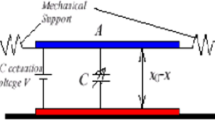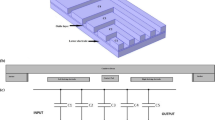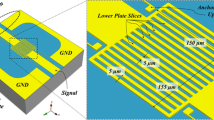Abstract
Due to their excellent quality factor in microwave frequency range, microelectromechanical (MEMS) varactors are an attractive choice for wireless communication engineers for building high performance telecommunication circuits. Significant progress in the technology of MEMS varactor has been reported over the past few years; however a comprehensive design methodology for the varactors based on some performance specifications is not reported. Also, it has been found that for the varactors fabricated with multi user processes (MUMPs), the measured capacitance deviates widely from the predicted value. In this work, it has been shown that a substrate-induced capacitance can change the expected capacitance of the varactor widely and can justify the deviation of the measured values to a good degree of accuracy. Here, a quantitative account of this difference has been presented. The capacitance profile of the varactor fabricated in PolyMUMPs process has been measured and the results show good agreement with the design values; thus indicating a clear influence of substrate induced capacitance on the varactor. Finally, a systematic design methodology of the varactor for a voltage controlled oscillator (VCO) application has been given.











Similar content being viewed by others
References
Bakri-Kassem M, Mansour RR (2009) Linear bilayer ALD coated MEMS varactor with high tuning capacitance ratio. J Microelectromech Syst 18(1):147–153
Carter J, Cowen A, Hardy B, Mahadevan R, Stonefield M, Wilcenski S (2005) PolyMUMPs design handbook: revision 11.0. MEMSCAP Inc., Durham
Chen J, Zou J, Liu C, Schutt-Ainé JE, Kang SM (2003) Design and modeling of a micromachined high-Q tunable capacitor with large tuning range and a vertical planar spiral inductor. IEEE Trans Electron Devices 50(3):730–739
Chen K, Liu X, Kovacs A, Chappell WJ, Peroulis D (2010) Antibiased electrostatic RF MEMS varactors and tunable filters. IEEE Trans Microw Theory Tech 58(12):3971–3981
Dec A, Suyama K (1997) Micromachined varactor with wide tuning range. Electron Lett 33(11):922–924
Dec A, Suyama K (1998) Micromachined electro-mechanically tunable capacitors and their applications to RF IC’s. IEEE Trans Microw Theory Tech 46(12):2587–2596
Dec A, Suyama K (2000a) Microwave MEMS-based voltage-controlled oscillators. IEEE Trans Microw Theory Tech 48(11):1943–1949
Dec A, Suyama K (2000b) A 1.9-GHz CMOS VCO with micromachined electromechanically tunable capacitors. IEEE J Solid State Circuits 35(8):1231–1237
Elshurafa AM, El-Masry EI (2010) MEMS variable capacitance devices utilizing the substrate: I. Novel devices with a customizable tuning range. J Micromech Microeng, 20 (045027)
Fang DM, Fu S, Cao Y, Zhou Y, Zhao XL (2007) Surface micromachined RF MEMS variable capacitor. Microelectron J 38(8–9):855–859
Fang DM, Jing XM, Wang PH, Zhou Y, Zhao XL (2008) Fabrication and dynamic analysis of the electrostatically actuated MEMS variable capacitor. Microsyst Technol 14(3):397–402
Fouladi S, Bakri-Kassem M, Mansour RR (2006) Suspended on-chip RF MEMS components fabricated using PolyMUMPs technology. Can J Electr Comput Eng 31(2):105–109
Heves E, Tekin I, Gurbuz Y (2008) A MEM-varactor tuned, 7.8 GHz differential LC voltage-controlled oscillator. Sens Actuators A: Phys 144(2):296–303
Huang IY, Sun CH, Tasi HC, Chou CY, Huang CS (2009) Development of a wide-tuning range and high Q variable capacitor using metal-based surface micromachining process. Sens Actuators A: Phys 149(2):193–200
Kampen RPV, Wolffenbuttel RF (1998) Modeling the mechanical behavior of bulk-micromachined silicon accelerometers. Sens Actuators: A 64(2):137–150
Koester DA, Mahadevan R, Shishkoff A, Markus KW (1996) SmartMUMP’s design handbook including MUMP’s introduction and design rules. MEMS Technology Applications Center, MCNC Research Triangle Park, NC
Mandal D, Bhattacharyya TK (2008) Implementation of CMOS low-power integer-N frequency synthesizer for SOC design. J Comput 3(4):31–38
Rebeiz GM (2003) RF MEMS, theory, design and technology. Wiley-Interscience, New York
Sharpe WN, Yuan B Jr, Vaidyanathan R (1997) Measurement of Young’s modulus, Poisson’s ratio and tensile strength of polysilicon. Proceedings of 10th IEEE International Workshop on Microelectromechanical Systems. Nagoya, Japan, pp 424–429
Tibeout M (2001) Low-power low-phase-noise differentially tuned quadrature VCO design in standard CMOS. J Solid State Circuits 36(7):1018–1024
Wei LC, Mohammad AB, Kassim NM (2002) Analytical modeling for determination of pull-in voltage for an electrostatic actuated MEMS cantilever beam. In: Proceedings of IEEE International Conference on Semiconductor Electronics, pp 233–238
Young DJ, Boser BE (1997) A micromachined-based RF low-noise voltage-controlled oscillator. IEEE custom integrated circuits conference 431–434
Acknowledgments
The authors would like to express their profound gratitude to Prof. Navakanta Bhat and his research group in the Department of Electrical Communication Engineering, Indian Institute of Science, Bangalore for their help in characterizing the devices using their facilities. This work is funded by National Programme on Smart and Micro Systems (NPMASS), Govt. of India.
Author information
Authors and Affiliations
Corresponding author
Rights and permissions
About this article
Cite this article
Bhattacharya, A., Chakraborty, S. & Bhattacharyya, T.K. A top-down design methodology of MEMS varactor for RF applications based on a substrate-induced capacitive model. Microsyst Technol 17, 1589 (2011). https://doi.org/10.1007/s00542-011-1337-4
Received:
Accepted:
Published:
DOI: https://doi.org/10.1007/s00542-011-1337-4




